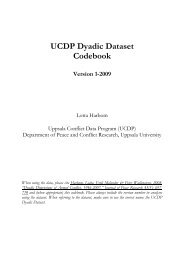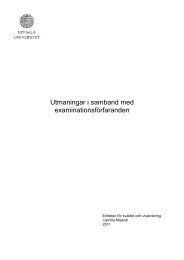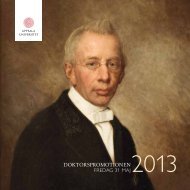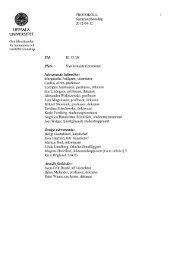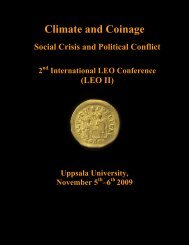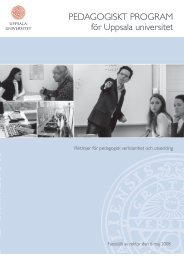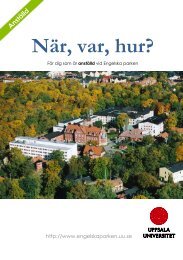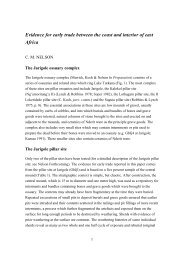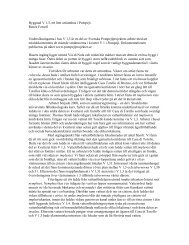Evaluation document, KoF11 Part A: Strategic aspects on research ...
Evaluation document, KoF11 Part A: Strategic aspects on research ...
Evaluation document, KoF11 Part A: Strategic aspects on research ...
Create successful ePaper yourself
Turn your PDF publications into a flip-book with our unique Google optimized e-Paper software.
Uppsala University 1<str<strong>on</strong>g>KoF11</str<strong>on</strong>g><str<strong>on</strong>g>Evaluati<strong>on</strong></str<strong>on</strong>g> <str<strong>on</strong>g>document</str<strong>on</strong>g>, <str<strong>on</strong>g>KoF11</str<strong>on</strong>g><str<strong>on</strong>g>Part</str<strong>on</strong>g> A: <str<strong>on</strong>g>Strategic</str<strong>on</strong>g> <str<strong>on</strong>g>aspects</str<strong>on</strong>g> <strong>on</strong> <strong>research</strong>Department of Social and Ec<strong>on</strong>omic Geography(Kulturgeografiska instituti<strong>on</strong>en)A1.i) Give a summary of the current <strong>research</strong> activities. State primary missi<strong>on</strong>s and goals aswell defined as possible.ii) List acti<strong>on</strong>s that would improve the quality of the department’s <strong>research</strong>, andobstacles that hinder improvement.iii) Describe interdisciplinary activities and networks, giving informati<strong>on</strong> <strong>on</strong> jointpublicati<strong>on</strong>s and funding, and provide statements <strong>on</strong> the suitability of the presentorganizati<strong>on</strong>al placement within Uppsala University.A1 (i) Summary of the current <strong>research</strong> activities.Research is characterized by c<strong>on</strong>siderable thematic, methodological and theoretical breadth.Since the last evaluati<strong>on</strong> we have reorganized our <strong>research</strong> around four central themes. Ourmissi<strong>on</strong> is to give form to areas where we have dem<strong>on</strong>strable thematic specializati<strong>on</strong> but alsoto c<strong>on</strong>struct broad group themes designed to avoid sub-disciplinary segmentati<strong>on</strong> and rivalryin order to encourage new c<strong>on</strong>versati<strong>on</strong>s and <strong>research</strong> directi<strong>on</strong>s. All academic staff c<strong>on</strong>tributeto at least <strong>on</strong>e of these <strong>research</strong> themes, and several of these are promoted by regular <strong>research</strong>meetings and seminars.Within and between these four thematic pillars our academic staff are characterized byc<strong>on</strong>siderable methodological and theoretical pluralism. Statistical analyses and spatialmodelling co-exist with in-depth case studies based <strong>on</strong> qualitative approaches. It is thisenriching and eclectic mix that we believe gives strength to our <strong>research</strong> culture and supportsboth thematic specialisati<strong>on</strong> and c<strong>on</strong>stant renewal.Theme 1: Culture, Creativity and Ec<strong>on</strong>omyThis group theme brings together work <strong>on</strong>: the geographic foundati<strong>on</strong>s of creativity; and thedynamics of the cultural and creative industries. Members of this theme are focused <strong>on</strong> themultiple geographies that underpin creativity and in two socio-spatial processes that underpinall types of cultural innovati<strong>on</strong> and creativity: individual learning and knowledge creati<strong>on</strong>; theassembly of individual knowledge in projects, firms and cultural artefacts and landscapes. Forboth the role of proximity is supposed to be crucial.Extensive work has been d<strong>on</strong>e <strong>on</strong> cultural and creative industries: <strong>on</strong> rapidlyexpanding inter-related and inter-dependent industries such as design, music, computergames, film and televisi<strong>on</strong>, new media, fashi<strong>on</strong>, visual arts and advertising. Creative andcultural industries are treated using commercial, industrial and geographical perspectives andattenti<strong>on</strong> is paid to the role of individuals as well as the districts and milieus where creativeindividuals and firms seem to thrive.2011-02-28 Department of Social and Ec<strong>on</strong>omic Geography v 1.0



